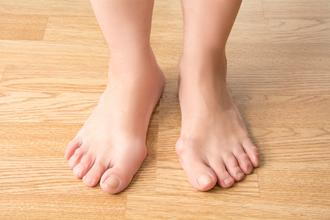Treating Your Bunions

- posted: Mar. 31, 2022
Have you been diagnosed with a bunion? A bunion is a common foot deformity that if left untreated can cause significant pain, swelling, structural changes and even trouble walking. Of course, it’s important to prevent a bunion from getting to this point, and the best way to do that is to turn to a podiatrist for a tailored-to-you treatment plan. The good news is that there are also some simple lifestyle changes you can make right now to slow the progress of your bunion.
Conservative Treatment Options
If a bunion is caught during the early stages, then you’re in luck. Most people can get away with at-home care and more conservative ways to manage their bunions. Most podiatrists will recommend conservative measures first to see if they ease bunion stiffness, pain and swelling. It’s when symptoms aren’t managed through these lifestyle changes that a podiatrist steps in to provide relief. Some conservative ways to treat bunions include,
- Icing the bunion for 15-20 minutes at a time to ease pain and swelling. This can be done 3-4 times a day, every day, as needed.
- Taking an anti-inflammatory such as ibuprofen that can reduce inflammation and pain (while medication only provides temporary relief, when you are in pain, this medication can certainly help)
- Stretching out the foot with special mobility exercises for the feet and ankles (ask your podiatrist or simply search online for some of the best foot stretches to ease bunion stiffness)
- Wearing proper footwear that provides the ideal cushioning, fit, and support
- Avoiding high heels, shoes that put pressure on the bunion, and shoes with a pointed toe
- Getting custom orthotics from a podiatrist (these custom-made shoe inserts can provide additional support for the deformed joint)
What happens if these options don’t work?
So, you’ve been trying to manage your bunion symptoms on your own but nothing seems to be working. Does this sound like you? If so, it’s time to employ the help of your trusty podiatrist. After all, that’s what they are there for. A podiatrist can provide you with the treatment plan you need when home care fails to provide you with the results you’re looking for. Your podiatrist may recommend splinting, padding or tapping, or may prescribe a stronger pain reliever. They can also suggest specialty footwear that can provide ample support. They can also determine if it’s time to get corrective bunion surgery.
If you adopt these simple solutions you may find that it drastically slows the growth of your bunions and may even keep you from needing surgery in the future. Of course, if your bunion is causing you severe pain, it’s always best to speak with a foot and ankle specialist to find out what you can do to better manage your symptoms.

- posted: Mar. 31, 2022
Have you been diagnosed with a bunion? A bunion is a common foot deformity that if left untreated can cause significant pain, swelling, structural changes and even trouble walking. Of course, it’s important to prevent a bunion from getting to this point, and the best way to do that is to turn to a podiatrist for a tailored-to-you treatment plan. The good news is that there are also some simple lifestyle changes you can make right now to slow the progress of your bunion.
Conservative Treatment Options
If a bunion is caught during the early stages, then you’re in luck. Most people can get away with at-home care and more conservative ways to manage their bunions. Most podiatrists will recommend conservative measures first to see if they ease bunion stiffness, pain and swelling. It’s when symptoms aren’t managed through these lifestyle changes that a podiatrist steps in to provide relief. Some conservative ways to treat bunions include,
- Icing the bunion for 15-20 minutes at a time to ease pain and swelling. This can be done 3-4 times a day, every day, as needed.
- Taking an anti-inflammatory such as ibuprofen that can reduce inflammation and pain (while medication only provides temporary relief, when you are in pain, this medication can certainly help)
- Stretching out the foot with special mobility exercises for the feet and ankles (ask your podiatrist or simply search online for some of the best foot stretches to ease bunion stiffness)
- Wearing proper footwear that provides the ideal cushioning, fit, and support
- Avoiding high heels, shoes that put pressure on the bunion, and shoes with a pointed toe
- Getting custom orthotics from a podiatrist (these custom-made shoe inserts can provide additional support for the deformed joint)
What happens if these options don’t work?
So, you’ve been trying to manage your bunion symptoms on your own but nothing seems to be working. Does this sound like you? If so, it’s time to employ the help of your trusty podiatrist. After all, that’s what they are there for. A podiatrist can provide you with the treatment plan you need when home care fails to provide you with the results you’re looking for. Your podiatrist may recommend splinting, padding or tapping, or may prescribe a stronger pain reliever. They can also suggest specialty footwear that can provide ample support. They can also determine if it’s time to get corrective bunion surgery.
If you adopt these simple solutions you may find that it drastically slows the growth of your bunions and may even keep you from needing surgery in the future. Of course, if your bunion is causing you severe pain, it’s always best to speak with a foot and ankle specialist to find out what you can do to better manage your symptoms.
